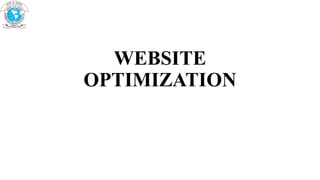
WEBSITE OPTIMIZATION.pdf
- 2. INTRODUCTION • Optimization is an act, process or methodology of making something (as a design, method or system) as fully perfect, functional, or effective as possible. • Website optimization is all about improving user experience so that people will be more likely to convert on your website. • systematically improving the performance of website to meet the business objectives. 17-04-2020 BBA 304 DM 2
- 3. WEBSITE OPTIMIZATION • It is also known as conversion rate optimization, it is the process of using controlled experimentation to improve a website’s ability to drive business goals. • Any potential customer who visits the site will like what they see and do something (call the company, submit a lead form, sign up for a newsletter, etc.). These actions are called “conversions” and the company’s “conversion rate” is the percentage of the visitors that actually do what company want them to do. • To improve the performance of their website, website owners implement A/B testing to experiment with variations on pages of their website to determine which changes will ultimately result in more conversions(eg- demo requests, increases in organic search results, more purchases, reduced customer service time, etc).
- 4. WEBSITE OPTIMIZATION • A/B testing (is also known as split testing or bucket testing) is a method of comparing two versions of a web page against each other to determine which one performs better. • A/B Testing takes the guesswork out of website optimization and enables data informed decisions that shift business conversations from “we think” to “we know”.
- 5. IMPORTANCE • Smooth user experience leads to happy customers • Increased revenue • Better conversion rates 17-04-2020 BBA 304 DM 5
- 6. How to optimize the website?- Process 17-04-2020 BBA 304 DM 6
- 7. 1.Establish a hypothesis/ideas – Review the analytics and look for parts of that are performing poorly, such as pages with high bounce or exit rates. Collect qualitative feedback from visitors as to why they’re not converting. 2. Prioritize – After building the list of potential optimizations, put them in priority order. Put them in a spreadsheet and rank them in order of their anticipated impact and how easy it is to implement the change. 3. Test your optimizations – A/B testing. Keep changes that improve the performance of your site, eliminate those that don’t. 4. Analyze tests – Review the testing data to determine which hypotheses were true and which weren’t. 5. Optimize your website – Put your winning tests into play and learn from tests that didn’t win. 17-04-2020 BBA 304 DM 7
- 8. THINGS TO OPTIMIZE • Landing pages- They are the first pages people encounter on the site. They click on a link and end up on a landing page. • Home page- Like the landing pages, the home page can make or break the conversion rate. So what works well on a landing page may not be right for the home page. • Checkout process- In case of ecommerce business, a smooth checkout process is vital to the success of the business. A little checkout process optimization can have big financial implications. • Conversion points- Like the checkout process, any conversion point-from a form to a click-to-call button- is a critical part of the website. The goal of the website is to get people to convert, so if the conversion process isn’t optimized, the company is just making things difficult for itself.
- 9. QUANTITATIVE WEBSITE OPTIMIZATION TOOLS • Google Analytics- It’s free and every company already have it set up on its website. Google Analytics is a web analytics service offered by Google that tracks and reports website traffic. • Kissmetrics- Through this, the company can look at specific user to see how people move through the site on their conversion journey. It is a web analytics solution that helps to get more customers, make smarter decisions, identify the marketing channels which produce the most valuable customers. • CrazyEgg- Crazy Egg is an online analytics application that provides you eye-tracking tools. It is a heat mapping software that gives company a visual representation of what people do on the site pages. It helps to gain insight as to how far people are scrolling down a page and even when they are clicking.
- 10. QUALITATIVE WEBSITE OPTIMIZATION TOOLS • Qualaroo- It provides people with on-site surveys that users can complete before they leave the site, thus enables the company to gain an insight to the visitors site experience. • UserTesting.com- This also enables to understand the visitor’s site experience. UserTesting.com will send the company recorded videos of people trying to do specific things on the site. • Feng-GUI- It attempts to predict how people will respond to the website using an algorithm based on data from thousands of eye tracking studies. It is an economical approach and can offer a lot more insights. Both, quantitative and qualitative tools have their pros and cons, neither of them gives the full picture on their own, thus it is better to try and use them together.
- 11. WEBSITE OPTIMIZATION TESTING TOOLS • Google content experiments(GCE)- It is a free tool inside of Google analytics, that helps in testing. However, the drawback with it is, it doesn’t give real-time results, so cannot be used by everyone. • Unbounce- If the company only needs to test a landing page, unbounce is the option. It is a powerful and easy-to-use system. • Optimizely- It is a more expensive option than Google Content Experiments, but it has additional features to provide additional insights into the results of the tests. • Visual Website optimizer (VWO)- It is quite economical than optimizely and has very intuitive interface, thus making it one of the favourite website optimization testing tools.